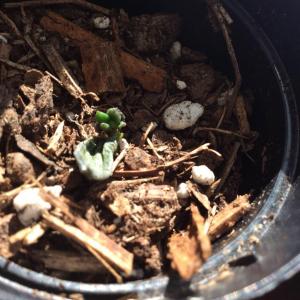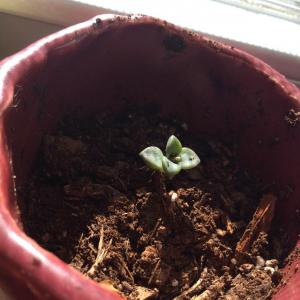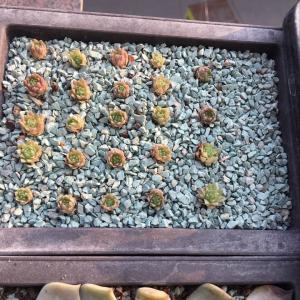成长记
oh-0kay
2017年11月04日

— 3 week update —
i moved the plant to my other window so it can get more light before the sun sets

i moved the plant to my other window so it can get more light before the sun sets

0
0
文章
Miss Chen
2017年11月03日

Although garlic (Allium sativum) is winter-hardy in U.S. Department of Agriculture hardiness zones 3 to 8, it's usually grown by home gardeners as an annual, its mature bulbs harvested after a single growing season. In Ohio, garlic should be planted in the fall or early spring so that it has plenty of time to develop before the end of summer.

Choosing a Variety
Garlic can be of either the soft-neck or hard-neck type. Soft neck garlic varieties often have larger bulbs and will store longer than hard-neck types, but hard-neck varieties tend to be more cold-hardy and are better suited to the climate in Ohio. Varieties that do well in the state include "Music," "German White" and "German Red."
Timing of Planting
Garlic plants put their energy into leaf development when the weather is cool, and once the days start to get warmer, leaf growth stops and bulb growth takes over. Consequently, the plants need plenty of time early in the growing season to develop enough foliage to fuel bulb development later.
Most of Ohio falls into USDA zone 6a; exceptions include areas along the Lake Erie shore and the southern part of the state, which are classified as USDA zone 6b. Other higher-elevation areas fall into USDA zone 5b. In these zones, planting cloves in the fall, starting in the third week of October, will give the plants a jump on the season and allow the leaves to start growing through the winter. Alternatively, you can plant cloves in the early spring, but planting later than March or early April in Ohio will not give the plants enough time to develop fully.
Site Selection
Garlic needs a location that gets full sun through much of the day. It also needs well-drained soil with a light enough texture to allow for good bulb development. A loose, crumbly loam will satisfy both of the those requirements. Heavy clay soils, however, may retain too much moisture and cause bulbs to rot, and dense soils may result in small or ill-formed bulbs. Raised beds will also help soil to drain better and prevent bulb rot.

Soil Preparation
Garlic plants are heavy feeders, and they benefit from substantial amendment of the soil when they're planted. Add organic compost to the planting bed both to increase the soil's organic content and to improve the soil's texture. Till 3 to 6 inches of organic compost into the top 12 inches of soil. In addition, add about 3 pounds of a balanced 10-10-10 fertilizer per 100 square feet of bed and work into the area prior to planting.
Clove Selection and Planting
It's best to buy seed garlic from a seed supplier or local grower. Supermarket garlic might grow in your garden, but when you know precisely what variety you're getting from a supplier, you're more likely to find a variety that will do well in your location.
Separate bulbs into individual cloves just prior to planting, taking care to leave the papery skin of the cloves intact. Choose the largest undamaged cloves to plant. Plant them with their tips facing upward between 1 and 1 1/2 inches deep; space the cloves 3 to 5 inches apart, and space rows of cloves 18 to 30 inches apart. Water the planting site until the soil is thoroughly moistened.
Garlic doesn't need much water after planting, but if the soil is dry and it's not likely to rain soon, water the newly planted cloves thoroughly.

Choosing a Variety
Garlic can be of either the soft-neck or hard-neck type. Soft neck garlic varieties often have larger bulbs and will store longer than hard-neck types, but hard-neck varieties tend to be more cold-hardy and are better suited to the climate in Ohio. Varieties that do well in the state include "Music," "German White" and "German Red."
Timing of Planting
Garlic plants put their energy into leaf development when the weather is cool, and once the days start to get warmer, leaf growth stops and bulb growth takes over. Consequently, the plants need plenty of time early in the growing season to develop enough foliage to fuel bulb development later.
Most of Ohio falls into USDA zone 6a; exceptions include areas along the Lake Erie shore and the southern part of the state, which are classified as USDA zone 6b. Other higher-elevation areas fall into USDA zone 5b. In these zones, planting cloves in the fall, starting in the third week of October, will give the plants a jump on the season and allow the leaves to start growing through the winter. Alternatively, you can plant cloves in the early spring, but planting later than March or early April in Ohio will not give the plants enough time to develop fully.
Site Selection
Garlic needs a location that gets full sun through much of the day. It also needs well-drained soil with a light enough texture to allow for good bulb development. A loose, crumbly loam will satisfy both of the those requirements. Heavy clay soils, however, may retain too much moisture and cause bulbs to rot, and dense soils may result in small or ill-formed bulbs. Raised beds will also help soil to drain better and prevent bulb rot.

Soil Preparation
Garlic plants are heavy feeders, and they benefit from substantial amendment of the soil when they're planted. Add organic compost to the planting bed both to increase the soil's organic content and to improve the soil's texture. Till 3 to 6 inches of organic compost into the top 12 inches of soil. In addition, add about 3 pounds of a balanced 10-10-10 fertilizer per 100 square feet of bed and work into the area prior to planting.
Clove Selection and Planting
It's best to buy seed garlic from a seed supplier or local grower. Supermarket garlic might grow in your garden, but when you know precisely what variety you're getting from a supplier, you're more likely to find a variety that will do well in your location.
Separate bulbs into individual cloves just prior to planting, taking care to leave the papery skin of the cloves intact. Choose the largest undamaged cloves to plant. Plant them with their tips facing upward between 1 and 1 1/2 inches deep; space the cloves 3 to 5 inches apart, and space rows of cloves 18 to 30 inches apart. Water the planting site until the soil is thoroughly moistened.
Garlic doesn't need much water after planting, but if the soil is dry and it's not likely to rain soon, water the newly planted cloves thoroughly.
0
0
文章
Miss Chen
2017年11月02日

Perennial strawberries (Fragaria × ananassa) are perennials that grow in U.S. Department of Agriculture plant hardiness zones 3 through 10. They grow best and accept plant nutrients in soil that has a pH from 5.5 to 6.

Strawberry types are divided among June-bearing varieties that yield one large crop in June, day-neutral varieties that yield strawberries throughout the growing season, and everbearing varieties that yield a June crop and one in early autumn. All three types are fertilized the same way at the start of the growing season. Day-neutral and everbearing have added needs during the summer.
Soil Amendments
More than three-fourths of strawberry roots are found in the top six inches of soil. If you have your soil tested and find minerals that are below the optimal level, work soil amendments into the top 6 to 8 inches of soil six months to one year before you plant your strawberries.
If your soil needs potassium, apply 1 1/2 cups of potassium chloride, 0-0-60, or potassium sulfate, 0-0-43, per 100 square feet of strawberry growing soil. Potassium sulfate is acceptable for organic gardeners. Mixing 14 cups of greensand to each 100 square feet is also acceptable for organic potassium. Greensand, mined from mineral deposits originally on the ocean floor, contains 3 percent potassium along with iron, magnesium, silica and other trace minerals.
If your soil lacks phosphorus, combine 2 1/2 cups of superphosphate, 0-20-0, or 1 cup of triple superphosphate, 0-46-0 to 100 square feet of soil. For organic phosphorus add 6 cups of bonemeal, 1-11-0, to 100 square feet.

Strawberries commonly suffer from a lack of boron in the soil. If no boron was added in the previous three to four years, mix 3/4 ounce of borax into a gallon of water and shake thoroughly. Spread this over 100 square feet of strawberry planting area, taking care not to apply too much. If you regularly amend your soil with compost, it should contain sufficient organic boron.
Growing Season Fertilizer
Two weeks before you plant strawberries, mix 2 pounds of water-soluble, granular 5-10-10 fertilizer into the top 6 to 8 inches of 100 square feet of soil.
Add fertilizer to newly planted strawberries in 6-inch bands on both sides of the rows. Use water-soluble, granular fertilizer and water well after application.
Six to eight weeks after planting, apply 1 pound of water-soluble, granular 5-10-10 fertilizer per 100 square feet of soil. If granules land on the strawberry leaves, knock them off with your hand or wash them off.
Adding nitrogen fertilizer in the spring before harvest may increase plant and berry diseases and cause excessive growth of stems and leaves. But if your plants are growing slowly and the leaves are light green, add 1/2 pound of 5-10-5 per 100 square feet of soil.
After harvesting June-bearing strawberries, remove weeds, cut back leaves and thin plants. Then add 1 to 2 pounds of 10-10-10 fertilizer per 100 square feet of soil in 6-inch bands beside the plants. Give the plants at least 1 inch of water per week to avoid salt injury from the fertilizer and to give the strawberries strong, new growth. One inch of water is roughly 6 gallons per square yard.
If your strawberries are growing in soil that has not been allowed to dry out, fertilize them again in late august with 1/2 pound of 10-10-10 fertilizer for each 100 square feet of soil.
Apply 1 pound of 10-10-10 fertilizer to 100 square feet of everbearing and day neutral strawberries in the middle of June and July and at the end of August.
Organic Fertilizers
Organic nutrients for strawberries are best added before they are planted, rather than later.
If you have time, plant oats in the area where you then plow them under a few weeks before you plant strawberries. The decaying oats will add nutrients to the soil.
Early spring is also when you should add 35 pounds of rabbit or poultry manure or 65 pounds of cow manure into the top 6 to 8 inches of 100 square feet of soil.

Strawberry types are divided among June-bearing varieties that yield one large crop in June, day-neutral varieties that yield strawberries throughout the growing season, and everbearing varieties that yield a June crop and one in early autumn. All three types are fertilized the same way at the start of the growing season. Day-neutral and everbearing have added needs during the summer.
Soil Amendments
More than three-fourths of strawberry roots are found in the top six inches of soil. If you have your soil tested and find minerals that are below the optimal level, work soil amendments into the top 6 to 8 inches of soil six months to one year before you plant your strawberries.
If your soil needs potassium, apply 1 1/2 cups of potassium chloride, 0-0-60, or potassium sulfate, 0-0-43, per 100 square feet of strawberry growing soil. Potassium sulfate is acceptable for organic gardeners. Mixing 14 cups of greensand to each 100 square feet is also acceptable for organic potassium. Greensand, mined from mineral deposits originally on the ocean floor, contains 3 percent potassium along with iron, magnesium, silica and other trace minerals.
If your soil lacks phosphorus, combine 2 1/2 cups of superphosphate, 0-20-0, or 1 cup of triple superphosphate, 0-46-0 to 100 square feet of soil. For organic phosphorus add 6 cups of bonemeal, 1-11-0, to 100 square feet.

Strawberries commonly suffer from a lack of boron in the soil. If no boron was added in the previous three to four years, mix 3/4 ounce of borax into a gallon of water and shake thoroughly. Spread this over 100 square feet of strawberry planting area, taking care not to apply too much. If you regularly amend your soil with compost, it should contain sufficient organic boron.
Growing Season Fertilizer
Two weeks before you plant strawberries, mix 2 pounds of water-soluble, granular 5-10-10 fertilizer into the top 6 to 8 inches of 100 square feet of soil.
Add fertilizer to newly planted strawberries in 6-inch bands on both sides of the rows. Use water-soluble, granular fertilizer and water well after application.
Six to eight weeks after planting, apply 1 pound of water-soluble, granular 5-10-10 fertilizer per 100 square feet of soil. If granules land on the strawberry leaves, knock them off with your hand or wash them off.
Adding nitrogen fertilizer in the spring before harvest may increase plant and berry diseases and cause excessive growth of stems and leaves. But if your plants are growing slowly and the leaves are light green, add 1/2 pound of 5-10-5 per 100 square feet of soil.
After harvesting June-bearing strawberries, remove weeds, cut back leaves and thin plants. Then add 1 to 2 pounds of 10-10-10 fertilizer per 100 square feet of soil in 6-inch bands beside the plants. Give the plants at least 1 inch of water per week to avoid salt injury from the fertilizer and to give the strawberries strong, new growth. One inch of water is roughly 6 gallons per square yard.
If your strawberries are growing in soil that has not been allowed to dry out, fertilize them again in late august with 1/2 pound of 10-10-10 fertilizer for each 100 square feet of soil.
Apply 1 pound of 10-10-10 fertilizer to 100 square feet of everbearing and day neutral strawberries in the middle of June and July and at the end of August.
Organic Fertilizers
Organic nutrients for strawberries are best added before they are planted, rather than later.
If you have time, plant oats in the area where you then plow them under a few weeks before you plant strawberries. The decaying oats will add nutrients to the soil.
Early spring is also when you should add 35 pounds of rabbit or poultry manure or 65 pounds of cow manure into the top 6 to 8 inches of 100 square feet of soil.
0
0
成长记
阿罗
2017年11月02日

重新水培。
斜切,泡多菌灵,阴处晾干(3:30-6:30)。
换晾晒5天的自来水,2L加阿司匹林肠溶片2片。这次定个位置绝不移动,半个月内不换水,看看能生根长大吗?

斜切,泡多菌灵,阴处晾干(3:30-6:30)。
换晾晒5天的自来水,2L加阿司匹林肠溶片2片。这次定个位置绝不移动,半个月内不换水,看看能生根长大吗?

0
0




















